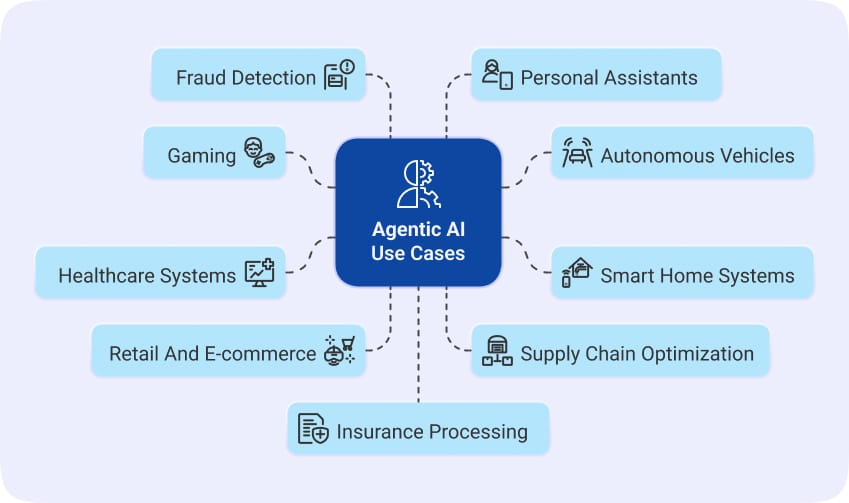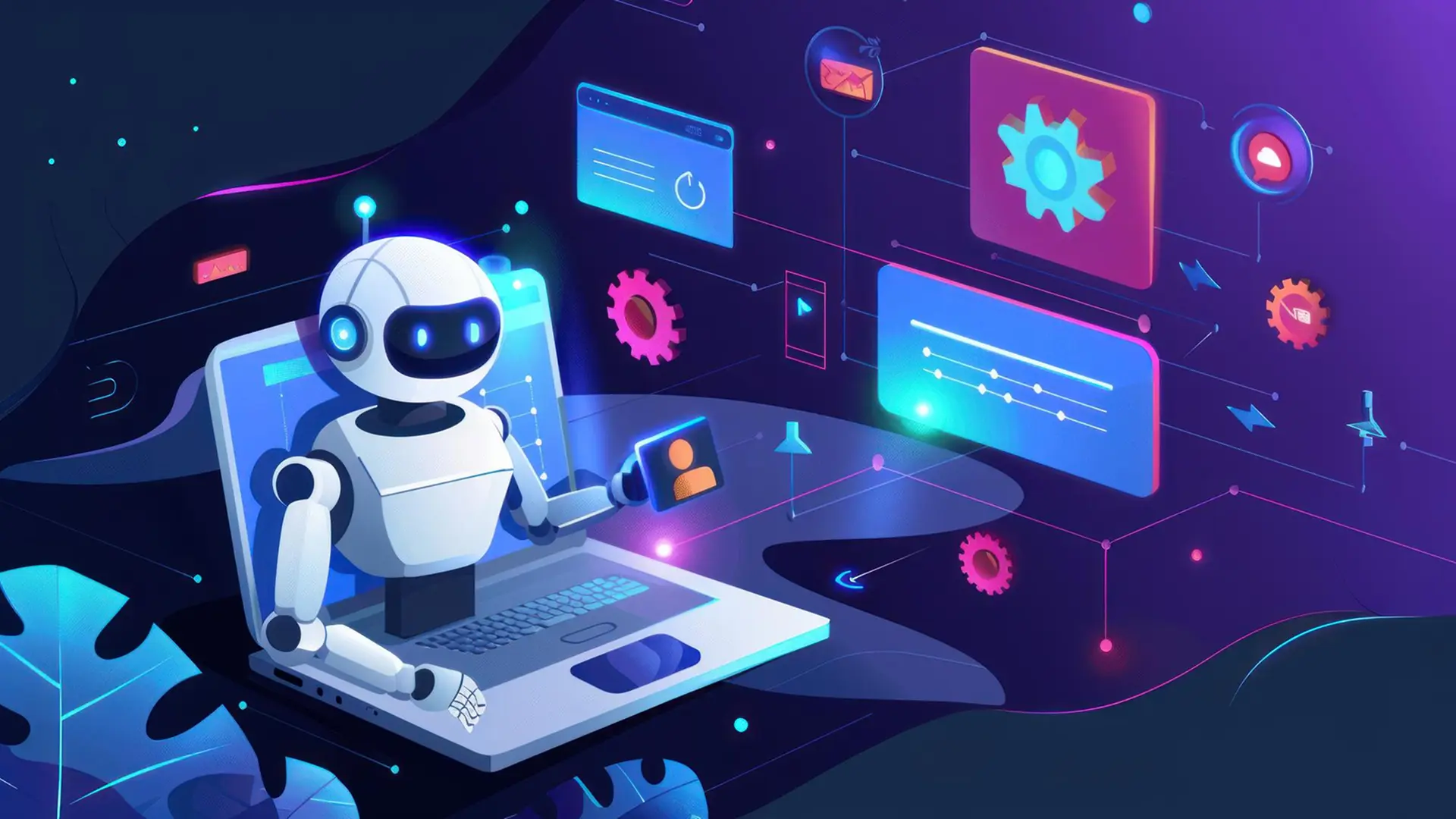- What Sets Agentic AI Apart From The Rest?
- Agentic AI Frameworks: The Building Blocks Behind The Scenes
- 1. AutoGen: Easy Teamwork Between AI Agents</a/>
- 2. LangGraph: Visualizing the AI’s Path
- 3. LangChain: Building Custom AI That Remembers
- 4. Crew AI: Coordinating AI Teams
- 5. Semantic Kernel: Keeping AI Context-Aware
- Essential Tools That Power Agentic AI
- Real-World Use Cases of Agentic AI: How Is It Making an Impact?
- Challenges with Agentic AI to Keep in Mind
- Why You Should Care About Agentic AI?
- How to Get Started with Agentic AI?
- Agentic AI Is Just Beginning!
Artificial intelligence is evolving constantly and a new kind of smart system is emerging—one that doesn’t just wait for instructions but takes initiative on its own. It’s Agentic AI. Unlike traditional AI, which mostly reacts when prompted, Agentic AI can plan, make decisions, and act independently, almost like a helpful assistant that can think ahead for you.
If you’re interested in how this kind of AI works, the tools behind it, and where it’s already making a difference, you’re in the right place. In this blog post, I’ll explain the core ideas behind Agentic AI, introduce some of the key tools developers use to build it, and share examples of how it’s changing industries.
What Sets Agentic AI Apart From The Rest?
Before getting into the tech details, let’s first understand what sets Agentic AI apart.
Picture this: Instead of a robot or program sitting idle until you tell it exactly what to do, imagine one that can figure out the best way to complete a task on its own. It can break a big goal into smaller steps, adjust its plans if things change, and remember past actions to improve its performance next time.
Such a kind of intelligence is called “agentic” because the system acts like an agent—an independent actor who doesn’t just follow orders but thinks and adapts. Here are the features of Agentic AI:
- Autonomy: It operates without needing constant instructions.
- Goal-Oriented: It sets goals and figures out how to achieve them step-by-step.
- Adaptability: It changes plans based on what’s happening around it.
- Memory: It recalls previous experiences and learns from them.
While traditional AI waits for commands and responds to simple prompts, Agentic AI looks ahead, anticipates challenges, and carries out tasks almost like a human collaborator.
Agentic AI Frameworks: The Building Blocks Behind The Scenes
Creating these smart, independent systems isn’t easy. Developers use special toolkits, called frameworks, that provide ready-made building blocks and guidelines to speed up the process. Each framework has its unique strengths and is suited for different needs.
Look at some of the most popular ones:

1. AutoGen: Easy Teamwork Between AI Agents
AutoGen, developed by Microsoft, is designed to let several AI agents work together smoothly. Think of it like a team where each member handles a different part of the problem, exchanging ideas and updates in real-time.
What AutoGen offers:
Allows multiple AI agents to communicate and collaborate.
Scales up to handle large, complex projects.
Works well with various existing software and systems.
Example: Customer support setups where different AI agents take care of billing questions, technical help, and collecting feedback all at once. It results in faster responses and happier customers.
2. LangGraph: Visualizing the AI’s Path
LangGraph helps AI systems keep track of complex workflows and dependencies between tasks. It uses visual graphs to map out each step clearly, so the AI knows what to do next and avoids mistakes.
Strengths:
Makes AI decisions easy to visualize.
Handles tasks that depend on each other smoothly.
Integrates well with business software.
Ideal for: Manufacturing or financial industries where precision and order are crucial, like assembly lines or transaction processing.
3. LangChain: Building Custom AI That Remembers
LangChain focuses on creating tailored AI applications. It connects language models with databases and APIs, allowing the AI to remember conversations and personalize responses.
Why it’s special:
Supports “memory” features for context-aware interactions.
Works with popular language models like GPT.
Connects with many types of data and external services.
Use cases: Custom chatbots, personal assistants, or automation tools designed for specific business needs.
4. Crew AI: Coordinating AI Teams
Crew AI acts like a project manager for AI agents. It assigns tasks and keeps track of how they work together toward a shared goal.
Features:
Automates task delegation among agents.
Supports teamwork toward common objectives.
Customizable for different industries.
Example: Supply chain management or event planning, where many moving parts need close coordination.
5. Semantic Kernel: Keeping AI Context-Aware
Semantic Kernel helps AI systems understand and respond to real-time context. It’s useful when AI needs to be aware of user behavior or changes in the environment.
Benefits:
Tracks real-time context.
Integrates with popular business tools.
Improves relevance and responsiveness.
Perfect for: Customer service or marketing where catching the “right moment” matters.
Essential Tools That Power Agentic AI
Frameworks lay the foundation, but building real-world Agentic AI applications requires other tools too. These tools help make AI smarter, faster, and easier to manage.
- Language Models and APIs
Many Agentic AI systems use large language models (LLMs) like GPT-4. These are like the brains that understand language and generate human-like text. Developers access them through APIs—ready-made interfaces that plug into their apps.
- Workflow Automation Platforms
Tools like Zapier or n8n help connect AI agents with other apps, automating repetitive tasks. This allows Agentic AI to interact smoothly with calendars, emails, databases, and more.
- Cloud Computing and Containerization
Running Agentic AI needs a lot of computing power, often spread over many servers. Technologies like Docker and Kubernetes help package and manage these systems in the cloud, making them reliable and scalable.
Real-World Use Cases of Agentic AI: How Is It Making an Impact?
Theory is interesting, but the real proof is in what Agentic AI can do today. Here are some areas where it’s already transforming how we work and live:
- Smarter Healthcare Management
Agentic AI helps coordinate patient care by scheduling appointments, monitoring health data, and assisting doctors in treatment planning. It reduces staff workloads and speeds up decision-making, leading to better patient outcomes.
For example, AI agents can remind patients to take medications, book follow-ups, and alert doctors to urgent symptoms—all on their own.
- Streamlined Supply Chains and Logistics
When we talk about logistics, Agentic AI plans delivery routes, manages inventories, and predicts supply-demand changes. Multiple AI agents work together in real time to keep operations running smoothly.
It helps companies reduce delays, cut costs, and improve customer satisfaction.
- Faster, Smarter Customer Support
Instead of one AI handling everything, Agentic AI uses teams of agents collaborating to answer questions, troubleshoot problems, and escalate issues when needed. Each agent learns from past interactions to provide better service over time.
- Personal Digital Assistants That Work
Agentic AI powers assistants that manage your calendar, book appointments, send reminders, and even handle emails—all on their own. Imagine an assistant who not only listens but also takes care of tasks before you even think about them.
- Boosting Business Productivity
From marketing to finance, Agentic AI automates routine workflows, tracks project progress, and alerts teams to important updates. It helps businesses stay nimble and efficient in fast-changing markets.

Challenges with Agentic AI to Keep in Mind
While Agentic AI is exciting, it’s not without hurdles:
- Ethics: AI decisions need to be fair and transparent, avoiding bias.
- Safety: Systems must be built with safeguards to prevent harmful actions.
- Complexity: Developing and maintaining these systems requires expertise and ongoing work.
- Control: Monitoring autonomous AI without limiting its effectiveness can be tricky.
Addressing these concerns responsibly is key as the technology grows.
Why You Should Care About Agentic AI?
Agentic AI represents a big shift, from passive tools that wait for commands to active helpers that think and act. This will change how businesses operate, how professionals work, and how people interact with technology every day.
Whether you’re a developer, a business leader, or simply curious about technology, understanding these tools and ideas will help you stay ahead as the future unfolds.
How to Get Started with Agentic AI?
Ready to jump in? Here are some simple steps:
- Choose the right framework: For team collaboration, try AutoGen; for memory-driven AI, LangChain is a great start.
- Explore tutorials and communities: Many frameworks have excellent documentation and active users to help you learn.
- Build small projects: Start with simple AI assistants or automate daily tasks to gain hands-on experience.
- Learn the basics of language models: Understanding how GPT-like models work will help you customize AI behavior.
- Keep ethics in mind: From the beginning, consider privacy, fairness, and transparency.
Agentic AI Is Just Beginning!
The tools and frameworks powering Agentic AI are advancing quickly, opening new possibilities in healthcare, logistics, customer service, and beyond. The future isn’t just about AI responding to us—it’s about AI taking initiative, adapting, and working alongside us.
If you want to build smarter apps, improve business efficiency, or simply stay curious about where technology is headed, exploring Agentic AI with professional AI ML services and tech assistance from Helius Work is a great place to start.
The age of active, independent AI agents is here, and it’s just getting higher.




